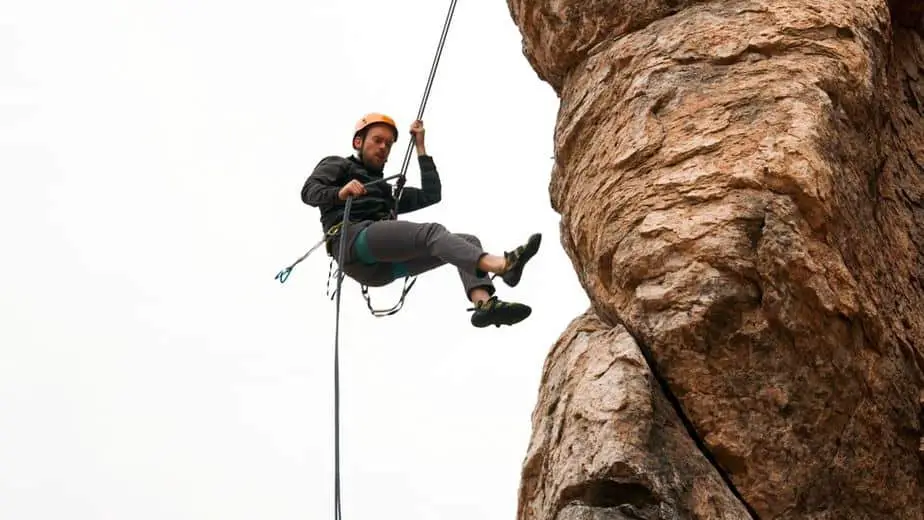There are lots of different variations of climbing harnesses, but they all do the same job. They provide an attachment point for a rope that protects a climber more comfortably and safer than just tying a knot around your waist.
A rock climbing harness has to hold a minimum of 15kN of force (~3,300 lbs of force) with the belay loop, and 10kN (or ~2,200 lbs of force) with the waist belt in order to be certified by the UIAA. Harnesses, like all climbing gear, are rated for force rather than weight because of the dynamic nature of their use.
There’s a really important nuance involved in climbing gear safety ratings, and that is the difference between weight and force. If the rope isn’t tight when you fall, then the jerk on the harness generates more force than just your body weight. It’s important to understand these forces and what other safety measures contribute to a climbing harness.
If you are worried about your own weight being too much for the harness, then you’re worried about the wrong thing. The harness is plenty strong- as long as the biggest size fits around your waist and legs.
What are the Strength Requirements for Climbing Harnesses?
There are two main governing bodies that certify gear for climbing. Gear that has been tested and is approved for climbing will be marked UIAA or CE. They go through rigorous testing in order to be certified safe for the tough environments we put them through.
Requirements for UIAA Certification:
- Belay Loops must withstand forces of up to 15kN
- Waist Belt must withstand forces of up to 10kN
- Slippage at buckles when under force must be 20mm max
- Straps that come in contact with body must be greater than 43mm wide
- Harnesses need to be marked with the year of manufacture
- Threads or stitching generally have to be a different color than the ‘tape’ so that climbers can discern if any threads have been worn or severed

These ratings are the minimum required, so many harnesses go above and beyond. Unlike carabiners and quickdraws and other gear, however, harnesses generally don’t specifically state the exact specifications. The UIAA or CE logo is enough to certify they are safe.
For the Gear that I use and recommend, check out our Recommended Gear Page .
.
Weight Versus Force
The physics equation of Force=mass*gravity yields the actual strength requirements for a carabiner catching a lead fall. The strength required to catch a falling climber is around ten times the weight of the climber due to the acceleration due to gravity of 9.8 m/s2. However; even with the gravity factor included, climbing gear is rated well above what climbers really need.
This is where we come up with the conversion of 15kN to 3,300 pounds. 15kN, or 15,000 N divided by the force of gravity (9.8 m/s2) equals about 1,500kg. Multiply that by 2.2 to get the weight in pounds (~3,300 lbs).
Just because a harness could lift a small car though doesn’t mean you should try it- they aren’t just used to lift static loads. They also need to be able to keep their integrity during the most extreme dynamic whippers. Based on the conversion of force to weight, a carabiner can lift a car.
The problem comes if you shock-load the carabiner by pushing the car off of a cliff and try to catch it with a rope and carabiner (theoretical of course, unless someone has an old car and a cliff we could experiment with?). Obviously in this situation, the rope or carabiner would snap.
With the weight of a human though, even a large human, the chance of breaking a harness is minimal or nonexistent.
A harness is only part of the system, read my articles How Much Weight Can A Carabiner Hold? and How Much Weight Can a Quickdraw Hold? for more information on the weakest link in your setup.
How Much Force Can Climbing Exert On Gear?
There’s a big difference between the strength of the carabiner in the correct orientation (20kN+) and across the minor axis (7kN+). If you calculate it, 7kN is about 1,573 pounds (~700kg). You don’t weight this much, but can you generate that much force if you take a really long fall?
The UIAA has done a lot of testing of the forces generated by a lead fall both in their labs as well as in the wild, and have found that the max amount of force a fall can generate on gear is 5kN. This is why top rope climbing is generally so much safer than lead climbing .
.
Petzl has done something similar, and found that they could get up to 6kN of force on the anchors. This is awfully close to the carabiner minimum strength requirements with an open gate or on the minor axis, but it’s pretty hard to take a fall that severe when you’re climbing.
Age Factor of Climbing Gear
It’s important to realize that the ratings shown on climbing gear are the strength factors the gear has when brand new. Climbing gear, slings and ropes especially, wears out over time.
Harnesses have a shelf life of 3-7 years, but can wear out faster if used a lot or left out in the sun. It’s important to inspect your gear before each use and look for wear on load-bearing portions of the harness.
Activities like canyoneering and crack climbing can really shred a harness quickly. Avoid rubbing your harness on rocks whenever possible and make sure it dries out completely if it ever gets wet. There’s no guarantee, so it’s best to err on the side of caution and replace them sooner rather than later. See my recommendation here .
.
Aluminum and steel carabiners will pretty much last forever if they aren’t used. They don’t really wear out over time just by sitting there. They do wear out with use though, which is easy to distinguish on colored carabiners. Sometimes gates become sticky when sandy as well.

Untested Counterfeit Climbing Harnesses
The growth and popularity of climbing, as well as the perceived high prices for high-quality climbing gear, have lead to low-cost competitors entering the market. It’s not easy or cheap to get harnesses to be strong enough to handle the rigors of climbing, and there is some cost involved in getting gear certified.
Most harnesses that aren’t rated for climbing are marked “NOT FOR CLIMBING” somewhere on them. This is to ensure they don’t get sued if you misuse it. Other manufacturers are trying to sell gear to climbers that hasn’t been properly tested and certified. This can be extremely dangerous, and has caused accidents in the field.
Harnesses designed for zip lines, tree work, hunting , or other uses may not be able to handle the dynamic forces unique to climbing. They usually have weight specs rather than force specs. They can hold your weight, but can’t catch your weight when it’s multiplied by gravity after a long fall.
, or other uses may not be able to handle the dynamic forces unique to climbing. They usually have weight specs rather than force specs. They can hold your weight, but can’t catch your weight when it’s multiplied by gravity after a long fall.
Some counterfeit gear manufacturers have recently gone as far as to mark CE on their gear in a different font, supposedly standing for “China Export” (even though it looks a lot like the certified gear logo).
The best way to avoid buying counterfeit gear is to buy gear from real climbing brands. If they’re willing to put their name on it, you can bet that it’s been through enough testing to keep them out of a lawsuit!
If in doubt, you can go to the UIAA website and check which brands and products they have certified, or can reach out to them to check.
and check which brands and products they have certified, or can reach out to them to check.
Related Questions:
How Strong is A Belay Loop? Belay loops have to withstand forces of up to 15kN, or about 3,300 pounds in order to be certified by the UIAA. This is more than strong enough to catch a falling climber, especially with dynamic rope stretch cushioning the fall.
Are Expensive Climbing Harnesses Worth It? Climbing harnesses all have to meet the same safety requirements, so expensive harnesses really aren’t necessary. As long as a harness fits well, is comfortable, and has ample gear loops, it will do the job. If you ice climb then you may need a specific harness with more loops.
How Long Can I Use A Climbing Harness? Manufacturers recommend using a harness for between 3-7 years. A harness stored in a box for 10 years should not be used. Each harness is different, and will wear out differently depending on frequency and type of use.

